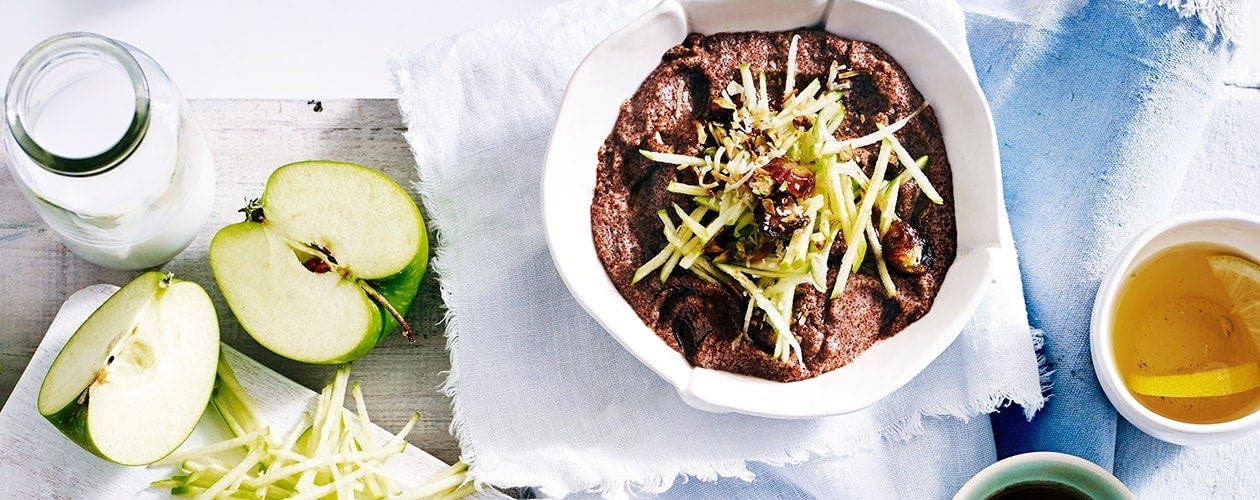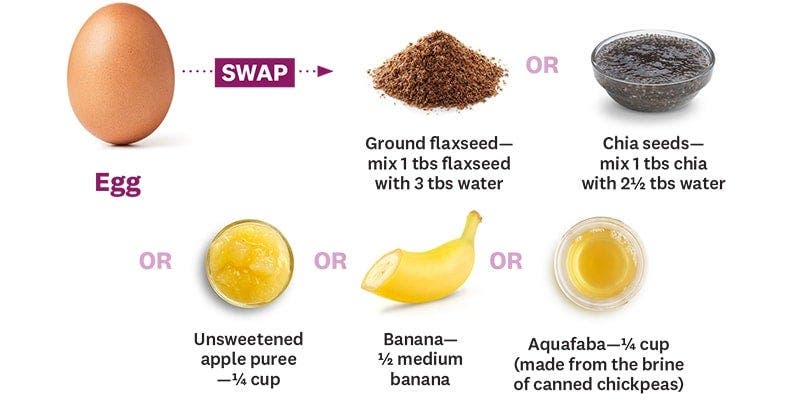What to eat on a vegan diet


A guide to eating vegan
Some chose to avoid animal products for health reasons, others for ethical ones, but all vegans eat a diet consisting of only plant-based foods. Unlike vegetarians, who might eat dairy, honey or eggs, many vegans will drink milk made from soy or other plants, drizzle agave nectar into their tea and eat scrambled tofu at breakfast.
Veganism as a way of life began to take hold in the 1940s, and over the last few decades, it (along with vegetarianism) has attracted millions of people worldwide. But merely giving up animal products doesn't automatically create a healthy diet.
Certain nutrients, including calcium, vitamins B12 and D, iron and omega-3 fatty acids, are less abundant in plant-based products. Highly processed vegan convenience foods can be just as full of fat, sugar, and sodium as their non-vegan counterparts. So make sure you’re in the know about what substitutes provide a healthier alternative for a plant based diet.
Vegan-friendly ingredients
If you’re going to eat a vegan diet you’ll need to familiarise yourself with certain key foods. These delicious, satisfying ingredients will help you get the nutrients you need.
Legumes
Beans, peas, and lentils are vegan staples — they provide protein, fibre and a host of vitamins and minerals. Some are also a good source of iron, which is a mineral that may be lacking in a vegan diet.
How to use them:
In soups, salads, mixed with grains or as the base for homemade veggie burgers.
Soy products
Soybeans are a type of legume that transform into a variety of fundamental vegan products.
How to use them:
- Soy milk is made from water cooked with ground soybeans, then filtered. It can typically be used as a direct substitute for cow’s milk such as in your morning coffee or breakfast cereal.
- Mild, spongy tofu, derived from soymilk in a process similar to cheese-making, comes in silken or firm varieties — the former used for purées and desserts, the latter for cubes, strips and chunks in savoury dishes.
- Tempeh is a fermented soybean cake with an earthy, meaty flavour. It is quite a versatile ingredient, however typically used as a meat substitute such as on the barbecue or in salads.
- Made from soy flour, TVP (texturised vegetable protein) comes in nuggets, flakes, crumbles or chunks, and when cooked, has a texture similar to ground meat.
- Soy cheese melts, so it works well for pizza or quesadillas.
- Miso, a paste made from fermented soybeans, adds a salty, deep flavour to dishes.
Seitan
Often used to make mock-meat products, seitan is a block of wheat gluten, formed by rinsing all the starch and bran from a basic flour dough. Making your own seitan can be easy, yet time consuming. Many people buy it ready-made, sometimes pre-seasoned. Read nutrition facts carefully, since as with any processed food, seasoned seitan can be high in sodium.
Nuts and seeds
More than just a filling nibble, these versatile foods play several roles in the vegan kitchen.
How to use them:
- Ground flaxseeds are an excellent source of omega-3 fatty acids, and give smoothies, porridge, and baked goods a nutritional boost.
- Chia seeds make an excellent natural thickener for soups, sauces and puddings.
- Cashews, soaked overnight, puréed into a spreadable 'cheese' or faux cream.
- Finely chopped walnuts can substitute for ground meat.
- Almonds easily transform into almond milk and nut butters.
Grains
While any type of grain can be part of a vegan diet, wholegrains, in particular, provide B vitamins as well as fibre and protein which will help you feel fuller for longer. Quinoa, brown rice, barley, bulgur, corn, and spelt are just a few options you could try.
How to use them:
Wholegrains can be cooked like pasta, boiled in a large pot of salted water, then drained; leftovers freeze well too.
Umami
Umami, the complex, funky 'fifth taste' (after sweet, salty, sour and bitter) that seduces you back for one more forkful, is easy to find in animal products like parmesan cheese, fish sauce, and cured meats. Vegans turn to nutritional yeast, mushrooms and sauerkraut, among other substitutes, for that satisfying flavour.
Vegetables
Generally speaking, vegetables add colour, crunch, and variety of nutrients, so you’ll want to keep a wide range in your fridge. It’s no secret vegetables are an important part of a vegan diet, however some are more crucial than others.
How to use them:
- Leafy greens provide both iron and calcium.
- Rich, creamy avocados replace butter or mayonnaise in baking and salad dressings, or simply spread on toast.
- Meaty mushrooms add an umami flavour to cooking.
- Pureed winter pumpkin or sweet potatoes supply creaminess to 'macaroni and cheese'.
Fruit
In addition to being the perfect portable snack, fruit helps adapt countless recipes to be vegan-friendly.
How to use them:
- Pureed bananas, dates or prunes, as well as applesauce, can all replace a portion of the fat in baked goods.
- Ripe bananas that have been frozen and pureed, make a decent stand-in for ice cream.
- Frozen fruit-juice concentrates replace liquid sweeteners measure-for-measure in recipes.
Fats
Taking butter off the table might seem like a challenge, especially for baking, but there are some fantastic vegan substitutions:
How to use them:
- In addition to avocados or fruit purées, bakers use coconut oil, a creamy solid when cold, or non-hydrogenated vegan vegetable shortening and margarine.
- Vegetable oils are perfect for muffins and quick breads.
- For your favourite macaroni salad, you’ll find vegan mayo in the natural-foods section of larger supermarkets.
Egg replacements
Depending on how the eggs will be used, you have several options.
How to use them:
- For thickening or binding dishes such as veggie burgers or casseroles, either try a moistened, starchy element like corn starch or breadcrumbs, or a creamy one like avocado or tahini.
- A tablespoon of ground flaxseeds or chia seeds mixed with 3 tablespoons of water can replace one egg in most baking recipes.
- Other possibilities include pureed banana, applesauce or silken tofu — or a ready-made vegan egg-replacer, which you’ll find in health-foods stores.
- To thicken fillings and custards, try agar-agar (a seaweed derivative), arrowroot or even all-purpose flour.
- Crumbled tofu makes an astonishingly convincing stand-in for scrambled eggs.
Herbs and spices
Because they’re all plant-based, herbs and spices are used liberally in vegan cooking. Spice mixes from around the globe liven tofu and bean dishes, while fresh herbs add a burst of flavour to salads, soups, and stews. Try spices like curry powder, Chinese five-spice powder, and chili powder.
Sweeteners
You may already know that honey is not an option for most vegans - it goes against the vegan ethos to exploit bees - but did you know that white, powdered and brown sugar can also cause problems? Cane sugar varieties may be processed using bone char, a charcoal derived from animal bones. To be sure your sugar is vegan, look for any of these terms on the label: evaporated cane juice, organic unbleached sugar, raw sugar or beet sugar. Maple, date or coconut-palm sugars are all vegan options. To replace honey, try maple syrup, molasses, rice malt syrup, agave nectar, golden syrup or concentrated fruit juice.
Techniques for cooking vegan meals
Sautéing and stir-frying
Because vegans don’t need to soften tough cuts of meat, many recipes cook quickly in a frying pan or wok. Try tossing a bunch of chopped vegetables, chunks of tofu or tempeh and your choice of seasoning — soy sauce or your favourite spice mixture — over medium-high heat and 10 minutes later, dinner is ready.
Steaming
Another quick-cooking technique, steaming has the advantage of using no added fat. Steaming is often the first step in preparing tempeh, and it streamlines the process of making seitan from scratch.
Braising
You may think of carnivorous classics like pot roast when you hear the word “braising,” but this slow-cooking technique works wonders with vegan recipes, too. This technique calls for browning food in a little-added fat, then pouring in a bit of liquid, covering and simmering for a long time. This adds tremendous amounts of flavour to blander vegan proteins like tofu and turns vegetables into exquisite, melt-in-your-mouth gems.
Roasting
A relatively short time (usually half an hour or less) in a hot oven transforms vegetables from average to spectacular. That high, dry heat caramelises the outside of the vegetables, lending a hint of sweet nuttiness, to virtually anything. Come holiday time, impressive roasts made with seitan or tempeh grace many vegan tables.
Baking
With an increase in popularity, vegan baking has improved over time. Butter can be replaced with vegan fats and as much as half the amount with pureed fruits, vegetables, even beans. As with any low-fat baking, take care not to over-mix, or the finished product might be unpleasantly tough and chewy. Vegan egg substitutes are sold in most natural-foods stores, or you can make your own using the techniques described above. Milk options are endless, with soy, almond, coconut, even grain-based varieties widely available.

